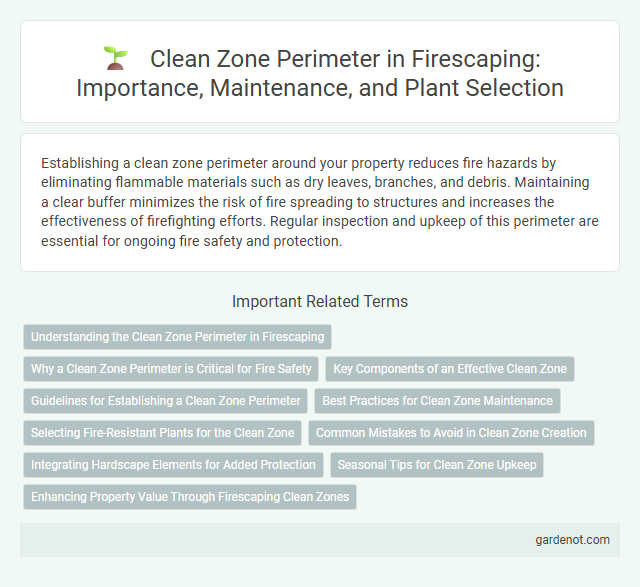Establishing a clean zone perimeter around your property reduces fire hazards by eliminating flammable materials such as dry leaves, branches, and debris. Maintaining a clear buffer minimizes the risk of fire spreading to structures and increases the effectiveness of firefighting efforts. Regular inspection and upkeep of this perimeter are essential for ongoing fire safety and protection.
Understanding the Clean Zone Perimeter in Firescaping
The clean zone perimeter in firescaping refers to a defensible space surrounding a structure, typically extending 30 to 100 feet, designed to reduce wildfire risk by removing flammable vegetation and debris. Creating this buffer zone slows or stops the spread of fire, allowing firefighters a safer area to operate while protecting buildings from heat and ember exposure. Proper maintenance of the clean zone perimeter involves regular clearing of dry leaves, dead plants, and overgrown shrubs to ensure continuous fire resistance.
Why a Clean Zone Perimeter is Critical for Fire Safety
A clean zone perimeter removes flammable materials and reduces vegetation density to create a defensible space that slows wildfire spread. Maintaining this barrier around structures minimizes heat exposure, decreasing the risk of ignition and structural damage. Fire safety experts emphasize that an effective clean zone perimeter enhances emergency response efficiency and protects lives and property.
Key Components of an Effective Clean Zone
Establishing a clean zone perimeter involves clearing all flammable vegetation and debris to create a defensible space around structures. Key components include maintaining a minimum radius free of dry brush, dead plants, and combustible materials, ensuring proper spacing between trees and shrubs, and using non-flammable ground covers like gravel or stone. Regular maintenance and inspection of the clean zone perimeter reduce wildfire risk and enhance fire suppression effectiveness.
Guidelines for Establishing a Clean Zone Perimeter
Establishing a clean zone perimeter requires maintaining a defensible space free of flammable materials around structures, typically extending 30 to 100 feet depending on vegetation density and slope. Guidelines emphasize removing dead plants, dry leaves, and combustible debris while keeping vegetation well-watered and trimmed to reduce fire fuel load. Implementing hardscape elements such as gravel or rock mulches helps enhance the effectiveness of the clean zone by creating firebreaks that limit wildfire spread.
Best Practices for Clean Zone Maintenance
Maintaining a clean zone perimeter involves systematically removing flammable vegetation, debris, and combustible materials within at least 30 feet around structures to reduce wildfire risks. Regular inspections and prompt removal of dead plants, leaves, and trash help sustain a defensible space that can slow or stop fire spread. Employing fire-resistant landscaping and using hardscape features like gravel or stone effectively enhances the clean zone's protective function.
Selecting Fire-Resistant Plants for the Clean Zone
Selecting fire-resistant plants for the clean zone perimeter reduces the risk of wildfires spreading to structures by creating a natural barrier. Plants such as manzanita, California lilac, and ice plant possess low resin content and retain high moisture, making them less flammable. Proper spacing and maintenance of these fire-resistant species optimize defensible space and enhance overall fire safety around properties.
Common Mistakes to Avoid in Clean Zone Creation
Establishing a clean zone perimeter requires precise clearance of flammable vegetation and debris, often overlooked when homeowners neglect underbrush and deadfall removal. Inconsistent maintenance and failure to properly space trees and shrubs can create fuel ladders, increasing fire risk within the clean zone. Ignoring these key practices compromises the effectiveness of clean zones in wildfire defense.
Integrating Hardscape Elements for Added Protection
Establishing a clean zone perimeter by integrating hardscape elements such as gravel beds, stone walkways, and retaining walls significantly reduces wildfire risks by creating non-combustible barriers around structures. These hardscape features disrupt the continuity of vegetation, limit the spread of flames, and enhance defensible space for firefighting efforts. Incorporating fire-resistant materials within the clean zone perimeter optimizes landscape resilience and protects property from ember attacks and direct flame exposure.
Seasonal Tips for Clean Zone Upkeep
Maintaining a clean zone perimeter is essential for effective firescaping, as removing dry leaves, dead vegetation, and combustible debris reduces wildfire risk. Seasonal upkeep includes regularly pruning shrubs, clearing gutters, and inspecting the area after heavy winds or storms to prevent accumulation of flammable materials. Implementing mulch with fire-resistant materials around plants and ensuring a minimum 30-foot defensible space enhances property protection during fire season.
Enhancing Property Value Through Firescaping Clean Zones
Establishing a clean zone perimeter by removing flammable vegetation and debris significantly enhances property value through effective firescaping strategies. This defensible space not only mitigates wildfire risk but also preserves landscaping aesthetics and structural integrity, appealing to insurance providers and potential buyers. Incorporating fire-resistant plants and maintaining clear access paths within the clean zone further optimize safety and marketability of residential properties.
Clean zone perimeter Infographic

 gardenot.com
gardenot.com